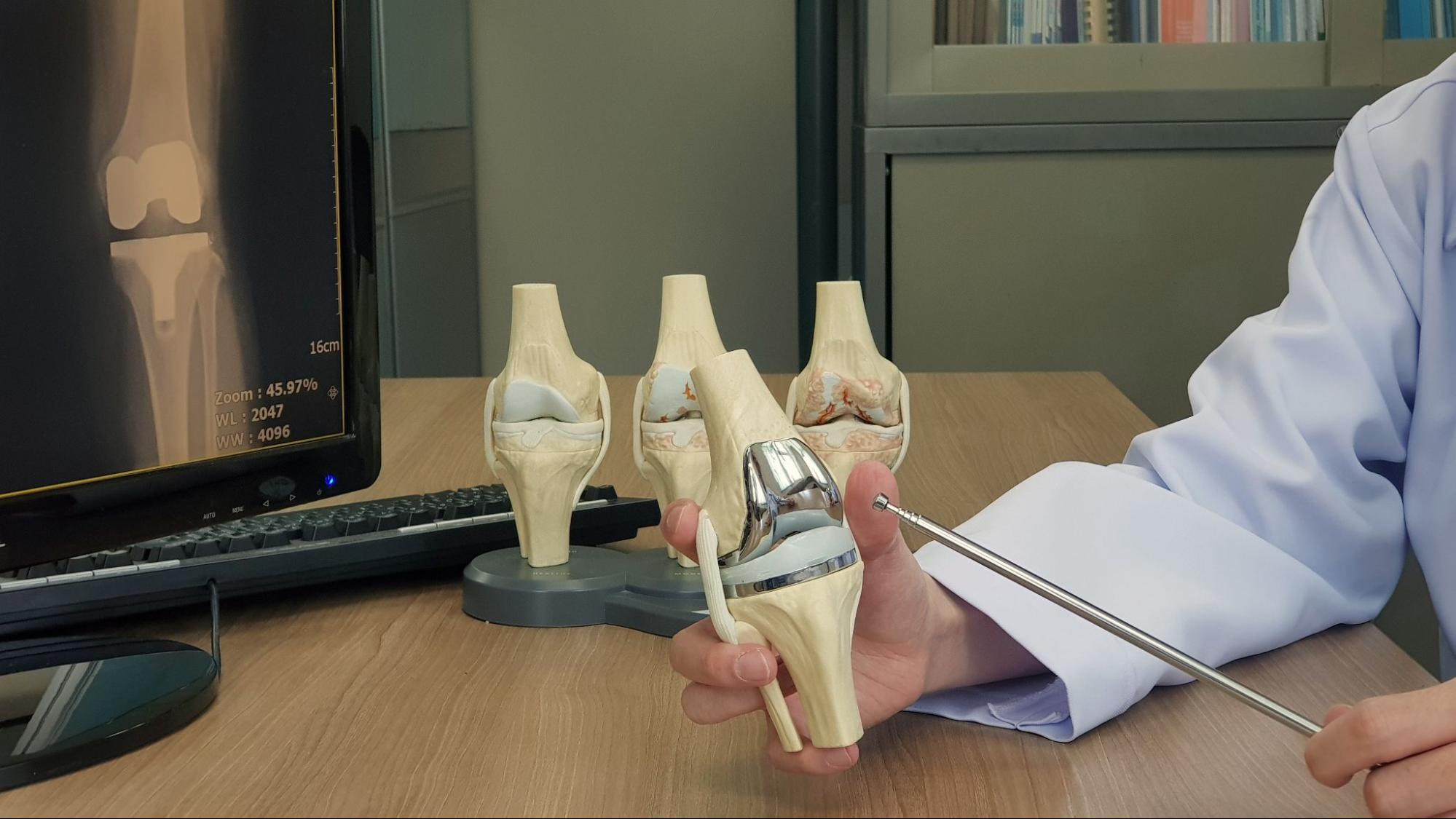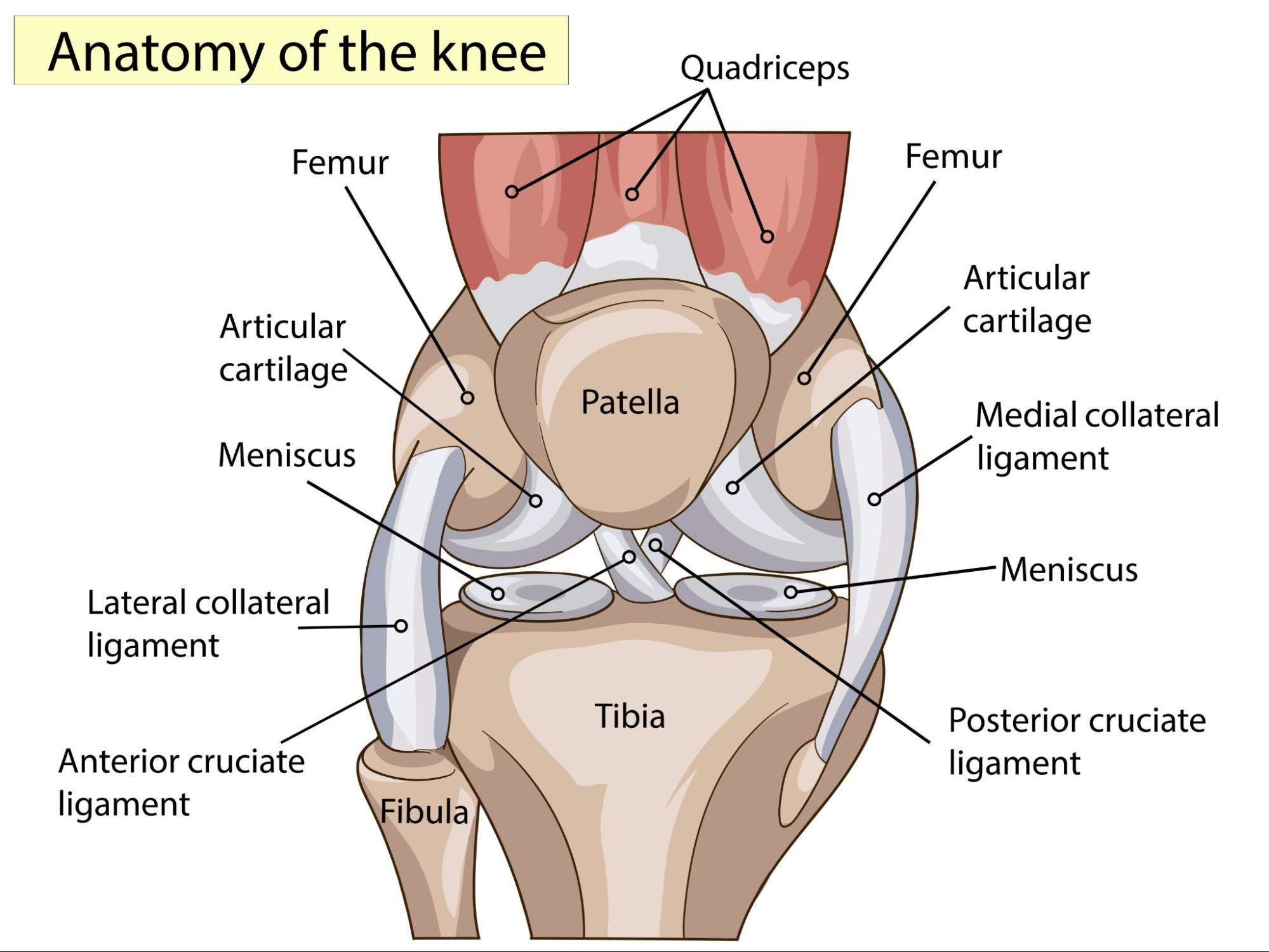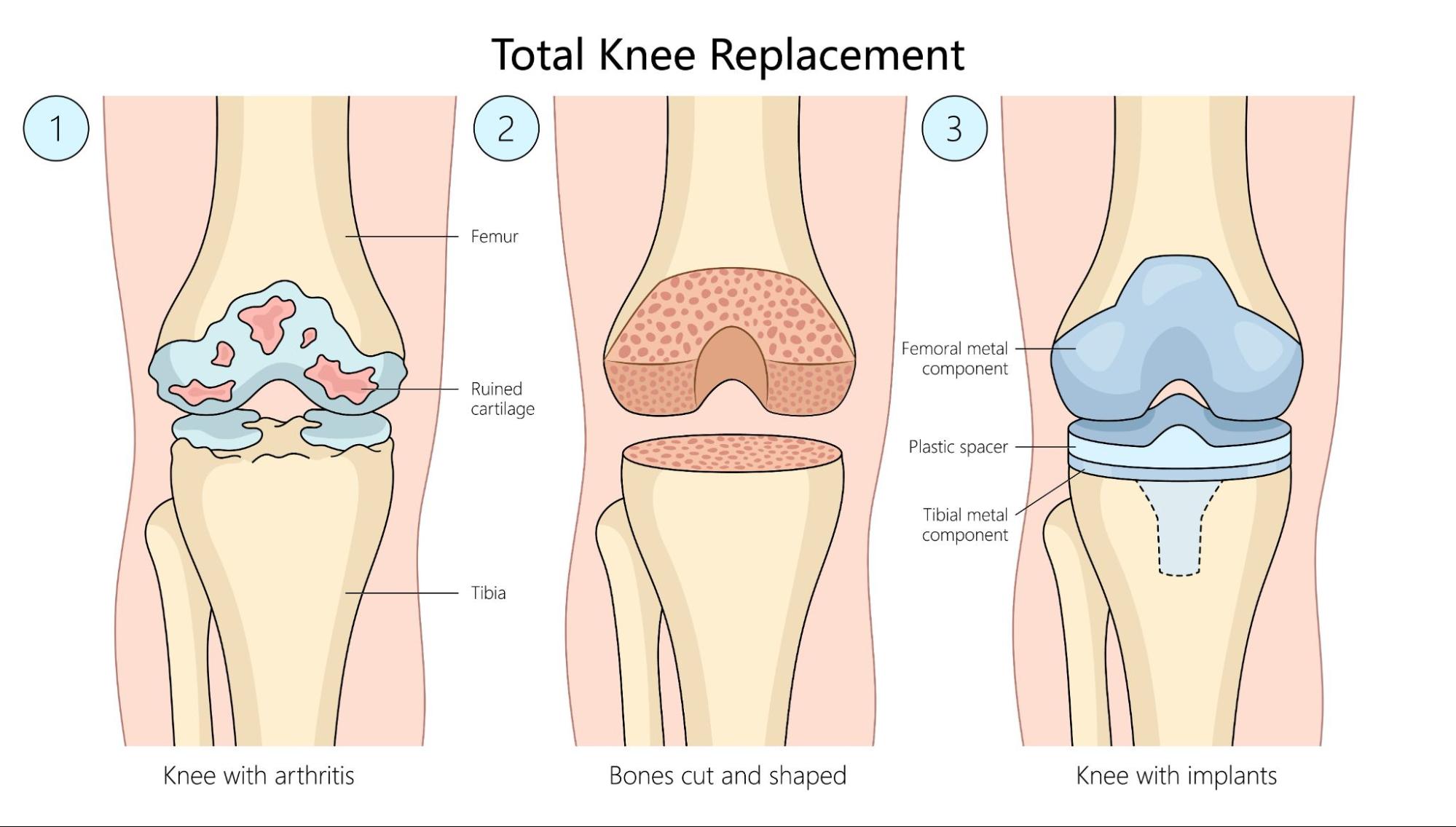Total Knee Replacement

Total knee replacements, also known as total knee arthroplasty (TKR), is a surgical procedure that replaces damaged bones and cartilages of the knee with a knee prosthetic usually made out of metal and plastic.
Knee replacement procedures are usually done as a last resort if patients do not respond to other types of treatment such as medications, injections, or physical therapy. Sometimes, if eligible, a partial knee replacement is recommended instead.
Knee anatomy
The knee joint connects the thigh bone (femur), shin bone (tibia), and the kneecap (patella). Other structures that surround these bones in the knee are the menisci and ligaments [1]. The ends of the bones are covered in hyaline cartilage, which allows movement of the bones with minimal friction. These layers of cartilage also allow for cushioning and load distribution across the joint.
Menisci of the knee consist of the lateral and medial meniscus, these are fibro-cartilaginous structures located between the femur and tibia. Menisci act as shock absorbers, and are also important in load distribution.
Ligaments of the knee are classified as collateral ligaments (medial and lateral) and cruciate ligaments (anterior and posterior). These ligaments are important in knee stabilisation and movement, such as flexion and extension. Other structures such as synovial membrane, muscles, and tendons surround the knee joint.
Together, these structures make up the knee and are crucial in maintaining proper function such as movement, stability, and weight-bearing. Damages to these structures can be painful and disabling.

The knee joint consists of bones, cartilages, menisci, and ligaments
What is a total knee replacement?
Knee arthroplasty simply refers to a procedure that restores the function of the knee joint with a prosthesis. A total knee replacement involves replacing the whole knee joint from the femoral condyles (the two rounded ends of the femur) to the tibial plateau (the flat surface where the femoral condyles meet the tibia), sometimes known as total condylar replacement [2].

Total knee replacement involves the structures from the femoral condyle to the tibial plateau.
What conditions require a total knee replacement?
Total knee replacement surgery is a common procedure, but is still a major surgery which is not indicated for minor or moderate conditions that can be treated with conservative measures. You may need a total knee replacement if you suffer from the following:
- Osteoarthritis – The most common indication for total knee replacements are for patients with osteoarthritis with severe knee pain, very limited ability to function, or in end-stage osteoarthritis. About 95% of all knee replacements are done for osteoarthritis [2].
- Rheumatoid arthritis – Rheumatoid arthritis is an autoimmune disorder that causes inflammation of the joints. Patients with severe pain and joint deformity of the knee due to rheumatoid arthritis are indicated for a total knee replacement [3].
- Post-traumatic arthritis – Post-traumatic arthritis is joint inflammation caused by an acute traumatic injury such as sports injury, motor vehicle accident, or blunt traumas. Post-traumatic arthritis is most commonly seen in younger patients. Despite being prone to complications, total knee replacement is an effective treatment for patients with post-traumatic arthritis as it improves their quality of life and joint function [4].
- Osteonecrosis – Osteonecrosis refers to the death of bone tissue due to a lack or a disruption in blood flow supplying nutrients to the bone tissues. This can lead to damage and break down of the bones. Osteonecrosis also commonly affects long bones such as the femur. Total knee replacement can be done to replace the damaged knee joint in osteonecrosis patients [5].
In addition to these conditions and diseases, total knee replacement can be done to treat other conditions that affect the joints, causing severe pain and limited mobility, which do not respond to non-operative treatments. These cases will be reviewed by the doctors and surgeons on a case-by-case basis.
What are the risks associated with a total knee replacement?
As with other surgical procedures, total knee replacements present operative risks such as:
- Blood clots – Formation of blood clots after surgery can lead to conditions such as deep vein thrombosis or a more serious pulmonary embolism. Blood clots can form after surgery due to long periods of being bed-ridden during recovery. To reduce these risks, your surgeon may give you anticoagulants or blood thinners.
- Nerve damage – During the surgery, there may be a possibility that the nerves are damaged where the implant is placed.
- Infections – Surgical procedures generally present a risk of infections. To reduce this risk, following proper post-operative care is important.
- Issues with the prosthetic implant – The implanted device may wear down or loosen over time.
- Scarring – Formation of scar tissues are a part of your body’s natural healing process. In the joints, excessive formation of scar tissues is called arthrofibrosis. This can affect your implant and cause joint stiffness [6].
- Reduced range of motion – A replaced knee will never be as good as your knee, it may not bend as well or may cause pain and discomfort to put pressure on the implant (such as by kneeling).
These risks can be minimised when the procedure is performed by a skilled and experienced surgeon. Following proper post-operative care also allows for further reduction of risks and complications during the recovery process. Talk to your orthopaedic surgeon if you have any doubts or questions for a total knee replacement surgery.
What to expect in a total knee replacement procedure?
Total knee replacement surgery can be advised during a consultation with an orthopaedic surgeon. The common process is as follows:
Before the procedure
- Consultation – Your doctor will explain the surgical procedure and what to expect before, during and after the surgery. This is when you can ask questions regarding the procedure
- Assessment – To plan the procedure, your doctor will take your medical history and perform several tests such as laboratory tests and imaging tests to ensure you are in good health to undergo the operation.
- Preparation – To prepare for your surgery, your doctor may require you to fast from the previous night. You will also be required to provide any information on allergies you have, medications you are taking, or other conditions the doctor needs to be aware of.
During the procedure
- Anaesthesia – The operation is done under general anaesthesia, where you will be unconscious. An anaesthesiologist will be in charge of giving the dosage and will be present during the surgery to monitor your condition.
- Surgery – The surgeon will perform the knee replacement surgery as they have planned.
After the procedure
- Hospital stay – After the surgery, you will be required to stay in the hospital for several days to monitor your condition.
- Physical therapy – It is important to move your knee prosthetic as soon as you can, a continuous passive motion (CPM) machine may be used in the first few days. In case of pain, medications will be given to manage it. A physical therapist will also discuss and plan an exercise programme for you. This programme is designed for you to follow while at home or in a rehabilitation centre to regain muscle strength and range of motion of your knee.
- At home – It is important to keep the wound clean and dry to avoid risks of infection. For this, showering and bathing will require protective coverings to keep it from getting wet. You are also advised to keep the limb elevated for the first dew days to reduce swelling. Doctors may also prescribe pain relievers to treat pain and inflammation while recovering.
Post-operative recovery from a total knee replacement
Most patients can come back to doing their normal activities 3 months after the operation, but it may take up to a year for your knee to fully recover, this also depends on other factors such as your age and health condition. Here are the common post-operative care instructions after a total knee replacement:
- Keep the incision wound clean and dry to avoid infections.
- Attend follow-up visits and check-ups regularly with your doctor to ensure proper healing.
- Follow the rehabilitation programme closely to regain your strength and mobility in your leg, this can also help you recover sooner.
- Apply safeguarding measures in your home such as installing handrails, using walking aids or crutches, and placing anti-slip mats to avoid injuries.
Lastly, it is also important to have occasional check-ups with your doctor to see if there is a need for a revision surgery. Typically, younger patients (< 55 years) will be more likely in need of a revision surgery during their lifetime [2].
Total knee replacement surgeries are one of the most common types of joint replacement surgery, but careful consideration should still be taken when opting for it. It is also good to be informed and aware of the risks and benefits of the surgery. For any questions or doubts about a total knee replacement, or whether it will be suitable for you, schedule an appointment with us for a detailed consultation and personalised treatment plan.
Frequently Asked Questions
Will the knee prostheses last for the rest of my life?
Knee prostheses generally last up to 20 years. However, this can depend on other factors such as your age, activity level, type of implant material, and whether there are any complications from the surgical procedure.
Who is not suitable for a total knee replacement?
Arthroplasty surgeons typically advise against a total knee replacement if you are [2]:
- Younger than 55 years – as the chances of a revision in your lifetime is higher.
- Obese – as there is a higher risk for post-operative complications.
What procedures can I not do if I have a total knee replacement?
Most people may be concerned about undergoing a magnetic resonance imaging (MRI) scan if they have implants. Although knee prostheses are generally safe to undergo MRI scans, it is still advisable to inform your doctor about any implants you have before undergoing any type of procedure.
Can I play sports again if I have a total knee replacement?
Yes, it is possible to come back to playing sports again after a total knee replacement. It may take time for your knee to fully recover and care should be taken as you may not have full range of motion with a knee replacement.
What is the difference between knee joint replacement and total knee replacement?
Knee joint replacement are surgical procedures to replace damaged parts of the knee joint, it can be total replacement or partial replacement. A total knee replacement is a type of knee joint replacement surgery where all of the components of the knee joint, including bone surfaces and soft tissues are replaced with a prosthetic.
How painful is a total knee replacement?
Surgery for a total knee replacement is done under general anaesthesia, hence you will be unconscious during the procedure. However, temporary pain and inflammation after the surgery is common. To manage this, doctors often prescribe pain medication for the first few days after surgery.
What is the best age to have a knee replacement?
There is no ideal age to have a knee replacement, although age is an important factor, several other factors also contribute to the decision of getting a knee replacement surgery. These may include the severity of joint damage, cause of joint damage (degenerative disease or traumatic injury), and disability caused by joint damage. Talk to your doctor to see if a knee replacement surgery is ideal for your condition.
Can you walk normally after a total knee replacement?
Yes, as you recover from the surgery you will be able to come back to your previous activity level. However, the process will take time and consistency in physical therapy and exercise plays an important role in your ability to walk normally again.
References
- Vaienti E, Scita G, Ceccarelli F, Pogliacomi F. Understanding the human knee and its relationship to total knee replacement. Acta Biomed. 2017 Jun 7;88(2S):6-16. doi: 10.23750/abm.v88i2-S.6507. PMID: 28657560; PMCID: PMC6178997.
- Price AJ, Alvand A, Troelsen A, Katz JN, Hooper G, Gray A, Carr A, Beard D. Knee replacement. Lancet. 2018 Nov 3;392(10158):1672-1682. doi: 10.1016/S0140-6736(18)32344-4. PMID: 30496082.
- Lee JK, Choi CH. Total knee arthroplasty in rheumatoid arthritis. Knee Surg Relat Res. 2012 Mar;24(1):1-6. doi: 10.5792/ksrr.2012.24.1.1. Epub 2012 Feb 28. PMID: 22570845; PMCID: PMC3341816.
- Saleh H, Yu S, Vigdorchik J, Schwarzkopf R. Total knee arthroplasty for treatment of post-traumatic arthritis: Systematic review. World J Orthop. 2016 Sep 18;7(9):584-91. doi: 10.5312/wjo.v7.i9.584. PMID: 27672572; PMCID: PMC5027014.
- Ng MK, Gordon AM, Lam A, Piuzzi N, Erez O, Scuderi G, Mont MA. Surgical Trends for Managing Knee Osteonecrosis: A 2010 to 2020 United States Nationwide Study. J Arthroplasty. 2023 Jun;38(6S):S125-S130. doi: 10.1016/j.arth.2023.01.038. Epub 2023 Feb 2. PMID: 36738865.
- Harmer JR, Wyles CC, Mara KC, Warner NS, Trousdale RT. Impact of Perioperative Pain Control on Knee Range of Motion and Development of Arthrofibrosis Following Primary Total Knee Arthroplasty. J Arthroplasty. 2021 Feb;36(2):532-536. doi: 10.1016/j.arth.2020.08.037. Epub 2020 Aug 25. PMID: 32933800.











